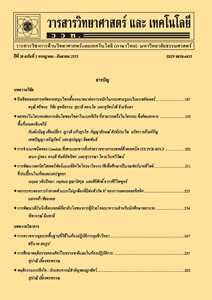สูตรที่เหมาะสมของการผลิตทอฟฟี่มะขามป้อม
Main Article Content
Abstract
This research aimed to optimize the formula to produce Indian gooseberry toffee. The seven formulations of Indian gooseberry toffee consisting of Indian gooseberry fresh, sugar and water at 25-50 % were studied by using mixture design. Physical properties and sensory acceptance were investigated. The results showed that weight loss of toffee varied directly to the amount of water. The hardness toffee varied indirectly to the amount of water and Indian gooseberry flesh, and brightness of toffee varied directly to the amount of sugar and Indian gooseberry flesh. Obviously, an optimum formulation of Indian gooseberry toffee was 34 % Indian gooseberry flesh, 33 % sugar and 33 % water. This formulation had the highest score of appearance (7.57±1.04), flavor (7.17±1.37), taste (7.07±0.87), texture (7.33±0.80) and overall liking (7.30±1.15). Furthermore, the addition of other fruits to Indian gooseberry (50 : 50) for reducing the astringent and bitter taste of toffee were studied. The results revealed that all toffee formulas had no significant difference (p > 0.05) on the average scores of appearance and flavor. Interestingly, okra formula had the highest score of taste (7.89±0.95) while mango formula had the highest score of texture (7.73±0.69). In term of overall liking, okra and mango formulas had an average score higher than other formulas. Therefore, toffee produced is an alternative value-added product for local raw materials, and it can answer to consumers who prefer eating Indian gooseberry.
Article Details
References
Thothong, S., Kameesak, S., Chalaket, J., Eakkapan, A. and Aonboon, P., 2016, Physical characteristics of different varieties of Phyllanthus emblica, Songklanakarin J. Plant Sci. 3(3)(Suppl.): 13-22. (in Thai)
Pitiporn, S., 2016, Indian Gooseberry, Available Source: https://lib3.dss.go.th/fulltext/techno_file/CF81/CF81(D3).pdf, February 9, 2019. (in Thai)
Thai Industrial Standards Institute, 2016, Community Product Standards: Toffee (256/2559), Available Source: https://www.tisi.go.th, February 9, 2019. (in Thai)
Duncan, D.B., 1995, Multiple range and multiple F-tests, Biometrics, 11: 1-42.
Rungsadthong, V., 2014, Food Processing Technology, King Mongkut's University of Technology North, Text and Journal Publication Co. Ltd., Bangkok, 477 p. (in Thai)
Pornchaloempong, P. and Rattanapanone,
N., Evaporation, Available Source: https://www.foodnetworksolution.com, February 5, 2019. (in Thai)
Kaewnoo, T. and Phonrak, H., 2017, Sugar science, J. Sugar 1(1): 33-51. (in Thai)
Charoenrein, S and Reepholkul, K., 2013, Glass transition of sugar during production of peanut brittle, Food 43(3): 74-81. (in Thai)
Rattanapanone, N., 2014, Food Chemistry, Bangkok, Odeon Store, 504 p. (in Thai)
Suphamityotin, P., 2013, Fruit and Vegetable Technology, Bangkok, Odeon Store, 280 p. (in Thai)
Niwaspragrit, C., Munyanont, M., Jaisin, Y. and Ratanachamnong, P., 2013, Study on physical properties, hydrolyzable tannin contents and free radical scavenging activities of Phyllanthus emblica Linn. from Kanchanaburi province, Thai J. Pharm. 35(1): 3-13. (in Thai)
Thonkaew, J., 2000, Determination of Pectin Content from Melon Plant, Research Report, Chiang Mai Rajabhat University, Chiang Mai, 43 p. (in Thai)
Bello-Perez, L.A., Garcia-Suarez, F.J.L. and Agama-Acevedo, E., 2007, Mango carbohydrates, J. Food. 1: 36-40.


